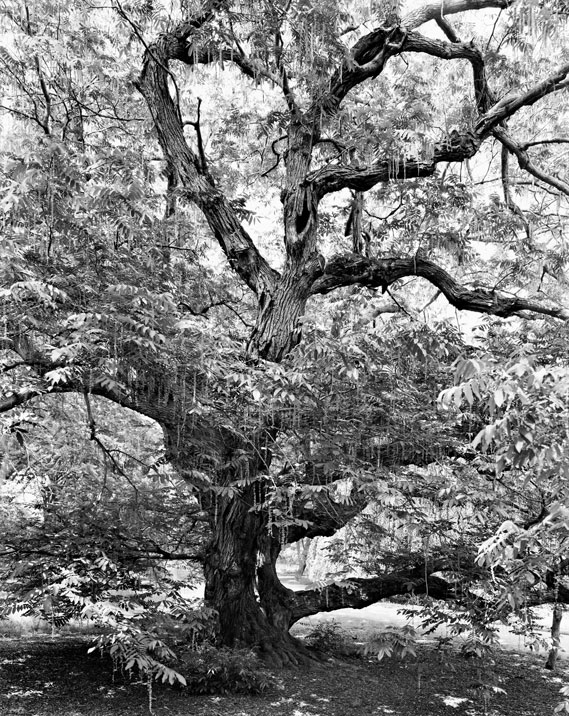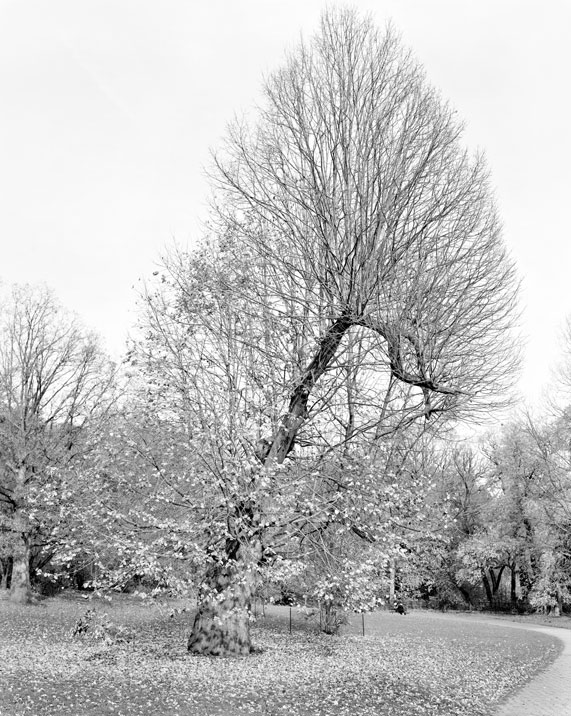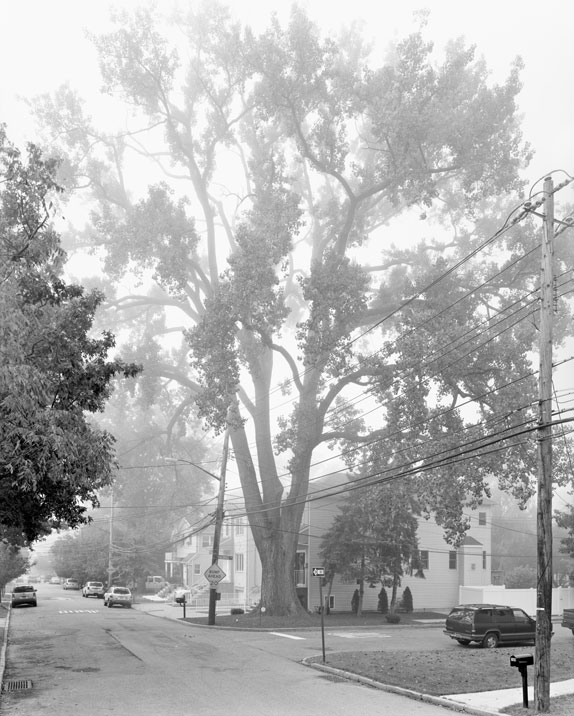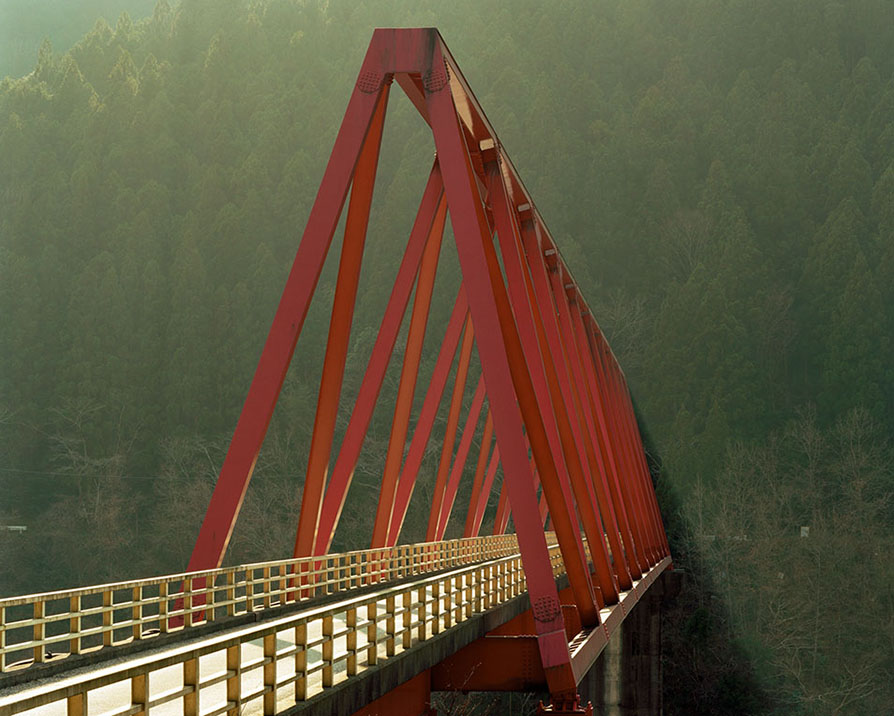Dmichael.williams
Shared posts
Behind a Little House Project: Dramatic Changes in Landscape Behind a Tiny House








For his Behind a Little House Project Italian photographer Manuel Cosentino found an unsuspecting muse: a tiny nondescript house on an unexceptional hill. He returned to photograph the small building from the exact same location for nearly two years in order to capture the dramatic changes in weather and light that utterly changed the scenery just beyond the horizon. As part of a traveling exhibition the photos are mounted on a wall behind a book containing copies of a photo of the house against a white sky. Viewers are then invited to draw their own interpretation of what appears behind the little house. Via his artist statement:
The first photograph starts the series with a Big-Bang-like explosion and sets everything into motion, the last is a new beginning – it represents that piece of “carte blanche” that we are all given with our lives. By drawing in the book anyone is at the same time breathing life into it, keeping it alive page after page, and is also responsible for his or her contribution within a wider context.
The entire project is currently on view at Klompching Gallery in New York as part of their Annual Summer Show through August 10th. (via reddit)
Every hour is precious

In March of 1886, at the age of 26, acclaimed Russian author and physician Anton Chekhov wrote this fascinating and honest letter of advice to his troubled older brother, Nikolai, a talented painter and writer who, despite being just 28 himself, had for many years been plagued by alcoholism to the point where he often slept on the streets, his days a blur; his notable skills as an artist largely untapped. This letter and the list it contained—eight qualities exhibited by "civilized" people—were essentially Anton's attempt at knocking some sense into the brother he was slowly losing.
Sadly, his efforts were ultimately futile. Nikolai passed away three years later.
(Source: James Vane; Translation by Michael Henry Heim; Image: Anton Chekhov, via.)
Moscow, March, 1886
My little Zabelin,
I've been told that you have taken offense at gibes Schechtel and I have been making. The faculty of taking offense is the property of noble souls alone, but even so, if it is all right to laugh at Ivanenko, me, Mishka and Nelly, then why is it wrong to laugh at you? It's unfair. However, if you're not joking and really do feel you've been offended, I hasten to apologize.
People only laugh at what's funny or what they don't understand. Take your choice.
The latter of course is more flattering, but—alas!—to me, for one, you're no riddle. It's not hard to understand someone with whom you've shared the delights of Tatar caps, Voutsina, Latin and, finally, life in Moscow. And besides, your life is psychologically so uncomplicated that even a nonseminarian could understand it. Out of respect for you let me be frank. You're angry, offended...but it's not because of my gibes or of that good-natured chatterbox Dolgov. The fact of the matter is that you're a decent person and you realize that you're living a lie. And, whenever a person feels guilty, he always looks outside himself for vindication: the drunk blames his troubles, Putyata blames the censors, the man who bolts from Yakimanka Street with lecherous intent blames the cold in the living room or gibes, and so on. If I were to abandon the family to the whims of fate, I would try to find myself an excuse in Mother's character or my blood spitting or the like. It's only natural and pardonable. It's human nature, after all. And you're quite right to feel you're living a lie. If you didn't feel that way, I wouldn't have called you a decent person. When decency goes, well, that's another story. You become reconciled to the lie and stop feeling it.
You're no riddle to me, and it is also true that you can be wildly ridiculous. You're nothing but an ordinary mortal, and we mortals are enigmatic only when we're stupid, and we're ridiculous forty-eight weeks of the year. Isn't that so?
You often complain to me that people "don't understand" you. But even Goethe and Newton made no such complaints. Christ did, true, but he was talking about his doctrine, not his ego. People understand you all too well. If you don't understand yourself, then it's nobody else's fault.
As your brother and intimate, I assure you that I understand you and sympathize with you from the bottom of my heart. I know all your good qualities like the back of my hand. I value them highly and have only the greatest respect for them. If you like, I can even prove how I understand you by enumerating them. In my opinion you are kind to the point of fault, magnanimous, unselfish, you'd share your last penny, and you're sincere. Hate and envy are foreign to you, you are open-hearted, you are compassionate with man and beast, you are not greedy, you do not bear grudges, and you are trusting. You are gifted from above with something others lack: you have talent. This talent places you above millions of people, for there is only one artist for every two million people on earth. It places you in a very special position: you could be a toad or a tarantula and you would still be respected, because talent is its own excuse.
You have only one failing, the cause of the lie you've been living, your troubles, and your intestinal catarrh. It's your extreme lack of culture. Please forgive me, but veritas magis amicitiae. The thing is, life lays down certain conditions. If you want to feel at home among intellectuals, to fit in and not find their presence burdensome, you have to have a certain amount of breeding. Your talent has brought you into their midst. You belong there, but...you seem to yearn escape and feel compelled to waver between the cultured set and your next-door neighbors. It's the bourgeois side of you coming out, the side raised on birch thrashings beside the wine cellar and handouts, and it's hard to overcome, terribly hard.
To my mind, civilized people ought to satisfy the following conditions:
1. They respect the individual and are therefore always indulgent, gentle, polite and compliant. They do not throw a tantrum over a hammer or a lost eraser. When they move in with somebody, they do not act as if they were doing him a favor, and when they move out, they do not say, "How can anyone live with you!" They excuse noise and cold and overdone meat and witticisms and the presence of others in their homes.
2. Their compassion extends beyond beggars and cats. They are hurt even by things the naked eye can't see. If for instance, Pyotr knows that his father and mother are turning gray and losing sleep over seeing their Pyotr so rarely (and seeing him drunk when he does turn up), then he rushes home to them and sends his vodka to the devil. They do not sleep nights the better to help the Polevayevs, help pay their brothers' tuition, and keep their mother decently dressed.
3. They respect the property of others and therefore pay their debts.
4. They are candid and fear lies like the plague. They do not lie even about the most trivial matters. A lie insults the listener and debases him in the liar's eyes. They don't put on airs, they behave in the street as they do at home, and they do not try to dazzle their inferiors. They know how to keep their mouths shut and they do not force uninvited confidences on people. Out of respect for the ears of others they are more often silent than not.
5. They do not belittle themselves merely to arouse sympathy. They do not play on people's heartstrings to get them to sigh and fuss over them. They do not say, "No one understands me!" or "I've squandered my talent on trifles!" because this smacks of a cheap effect and is vulgar, false and out-of-date.
6. They are not preoccupied with vain things. They are not taken in by such false jewels as friendships with celebrities, handshakes with drunken Plevako, ecstasy over the first person they happen to meet at the Salon de Varietes, popularity among the tavern crowd. They laugh when they hear, "I represent the press," a phrase befitting only Rodzeviches and Levenbergs. When they have done a penny's worth of work, they don't try to make a hundred rubles out of it, and they don't boast over being admitted to places closed to others. True talents always seek obscurity. They try to merge with the crowd and shun all ostentation. Krylov himself said that an empty barrel has more chance of being heard than a full one.
7. If they have talent, they respect it. They sacrifice comfort, women, wine and vanity to it. They are proud of their talent, and so they do not go out carousing with trade-school employees or Skvortsov's guests, realizing that their calling lies in exerting an uplifting influence on them, not in living with them. What is more, they are fastidious.
8. They cultivate their aesthetic sensibilities. They cannot stand to fall asleep fully dressed, see a slit in the wall teeming with bedbugs, breathe rotten air, walk on a spittle-laden floor or eat off a kerosene stove. They try their best to tame and ennoble their sexual instinct... What they look for in a woman is not a bed partner or horse sweat, [...] not the kind of intelligence that expresses itself in the ability to stage a fake pregnancy and tirelessly reel off lies. They—and especially the artists among them—require spontaneity, elegance, compassion, a woman who will be a mother... They don't guzzle vodka on any old occasion, nor do they go around sniffing cupboards, for they know they are not swine. They drink only when they are free, if the opportunity happens to present itself. For they require a mens sana in corpore sano.
And so on. That's how civilized people act. If you want to be civilized and not fall below the level of the milieu you belong to, it is not enough to read The Pickwick Papers and memorize a soliloquy from Faust. It is not enough to hail a cab and drive off to Yakimanka Street if all you're going to do is bolt out again a week later.
You must work at it constantly, day and night. You must never stop reading, studying in depth, exercising your will. Every hour is precious.
Trips back and forth to Yakimanka Street won't help. You've got to drop your old way of life and make a clean break. Come home. Smash your vodka bottle, lie down on the couch and pick up a book. You might even give Turgenev a try. You've never read him.
You must swallow your pride. You're no longer a child. You'll be thirty soon. It's high time!
I'm waiting...We're all waiting...
Yours,
A. Chekhov
RSS Feed proudly sponsored by TinyLetter, a simple newsletter service for people with something to say.
Flickr Finds No. 32

Linda Tanner, GoingSLO on Flickr
Flickr Finds returns with its 32nd installment here on Colossal. These are just a few of my favorite photos seen on Flickr the last few weeks, I urge you to click through and learn more about all the different photographers. See previous Flickr Finds. (thnx, megan!)
shutterbug friday #14: chris killip
 |
| Helen and Hula-Hoop. Seacoal Beach, Lynemouth, Northumberland 1984 |
 |
| Boo on Horse, Lynemouth |
 |
| Boo and his Rabbit, Lynemouth, 1983. |
 |
Bever's First Day Out, Skinningrove, North Yorkshire |
 |
| Punks, Gateshead, Tyneside 1985 |
 |
| Angelic Upstarts at a Miners Benefit Dance at the Barbary Coast Club, Sunderland, Wearside |
 |
| Youth on Wall, Tyneside, 1976 |
 |
| Gateshead, Tyneside,1978 |
 |
| From: Arbeit / Work |
 |
| Watching the Parade, West-End, Newcastle, 1980 |
Wonderful Conceptual Photo-manipulations by 14-Year-Old Photographer “Fiddle Oak”
Today I discovered a photographer who has a camera named Betsy who tells me he’s been taking photographs for nearly six years. Y’know, since he was 8. I’m referring to Massachusetts-based photographer Fiddle Oak (his real name is Zev) who creates some impressive miniature photo-manipulations that he’s been sharing online with a growing audience for the last few years. Many of the images are a collaboration with Zev’s 18-year-old sister Nellie who helps with concepts and setup but all of the shooting and editing is done by Zev who is also frequently the subject of his own work. Somebody get this kid a scholarship to something. You can find much more of his work over on Flickr. (via david is going to die)
Giant New Sound Installation by Zimoun Inside an Abandoned Chemical Tank








Prolific sound artist Zimoun (previously here and here) has completed work on what may be his most ambitious project ever, a towering sound installation inside an abandoned toluene tank in Dottikon, Switzerland. The permanent installation uses 329 of the artist’s trademark prepared dc-motors and cotton balls that have been affixed to the inner tank walls, and relied on contributions from Hannes Zweifel Architecture, Davide Groppi, and many others. The result is a whirring, rhythmic soundscape that is completely camouflaged within an old factory. Via Zimoun’s artist statement:
Using simple and functional components, Zimoun builds architecturally-minded platforms of sound. Exploring mechanical rhythm and flow in prepared systems, his installations incorporate commonplace industrial objects. In an obsessive display of simple and functional materials, these works articulate a tension between the orderly patterns of Modernism and the chaotic forces of life. Carrying an emotional depth, the acoustic hum of natural phenomena in Zimoun’s minimalist constructions effortlessly reverberates.
Zimoun has completed several additional installations in the last few months, all of which can been seen on his website.
Weird Science’s plants supplement their meat diet with ant poop
The carnivorous plant orders a side of ant poop. A number of plants that live in nutrient-poor environments have developed the ability to obtain a dietary supplement: insects, which they trap and digest. What we here at Weird Science weren't aware of, however, is that some bugs can happily move in and out of the traps without feeling ill effects. In fact, some insects lay their eggs there, and their larvae develop and leave. So, one pitcher plant has turned this to its biological advantage, creating a mutualistic relationship in which it obtains nutrients from ant waste.
The species in question is a pitcher plant, which has a liquid-filled trap that doubles as a digestive bath for any prey it catches. The slick sides of the pitcher force most insects into a one-way trip to the digestive fluid, but a specific species of ant has made the pitchers its home (in fact, it's the only place they're found). In doing so, they steal the plants prey and drink its nectar. This should be a negative, yet the plants that host ants grow better. What gives?
As it turns out, they kill off another species that would freeload off the plant: mosquitos, which would otherwise spend their larval days living off the plant's nectar, then fly off when grown. By killing the mosquitos, the ants prevent this loss of nutrients. And, by living in the pitcher, they ensure some of the nutrients get returned as ant waste. As a side benefit, they keep the pitcher itself clean and slippery.
Read 4 remaining paragraphs | Comments
7 Days in Paris (5 Photos)
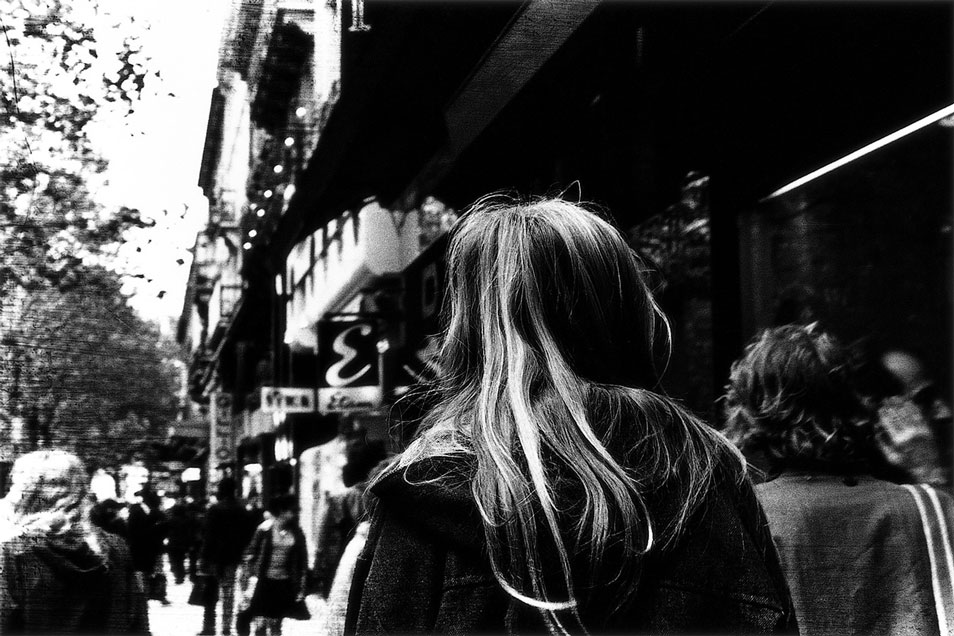 “Untitled,” 1971. All images © Takuma Nakahira, Courtesy Yossi Milo Gallery, New York
“Untitled,” 1971. All images © Takuma Nakahira, Courtesy Yossi Milo Gallery, New York
“Circulation: Date, Place, Events” was first exhibited in 1971 as part of the Seventh Paris Biennale. Each day, for seven consecutive days Takuma Nakahira photographed, developed and exhibited approximately one hundred photographs. The photographs are random glimpses from Nakahira’s daily activities in Paris, including strangers’ faces, produce stands, subway platforms, street posters and even his breakfast setting. Developing the photographs each night, Nakahira exhibited them the following day. Once the walls of the exhibition space were crowded with photographs, the artist spread them onto the floor. The resulting project presented a limited reality dictated by guidelines of “date,” “place” and “events.”
This is Japanese photographer Takuma Nakahira’s first exhibition outside of Japan since 1971 and first in America. The exhibition opens today and will be on view through Friday, July 12, 2013 at the Yossi Milo Gallery in New York City. An opening reception and book launch will be held this evening, Thursday, May 23, from 6:00 – 8:00PM.
“Untitled,” 1971
“Untitled,” 1971
“Untitled,” 1971
By shooting stark, black-and-white images that are purposely blurry and grainy, Nakahira broke with Japan’s photographic history of social realism and allowed elements of uncertainty and expression into his work, along with Shomei Tomatsu, Daido Moriyama and Koji Taki. For more on Tomatsu, click here.
Flickr Finds No. 31
At long last Flickr Finds returns with the 31st edition of my favorite photos seen on the newly redesigned Flickr over the last few weeks. For more photos see previous Flickr Finds. All photographs above courtesy the individual photographers.
IBM Watson on smartphones to make customer service bots less annoying

It's been more than two years since IBM's Watson kicked some human butt on Jeopardy, and now the artificial intelligence system is on the verge of making it onto smartphones. IBM today announced "Watson Engagement Advisor," software that lets businesses replace their current automated customer service systems with one that is based on Watson and is thus presumably much smarter.
Given the sorry state of automated customer service, it would be hard for Watson to make matters worse, and perhaps Watson will take away some of the pain of trying to talk to robots posing as customer service agents.
In the time since Watson wowed Alex Trebek, IBM's "research and development staff has made Watson 75 percent smaller, 25 percent faster, and have been working hard to improve Watson’s ability to answer consumer-oriented questions," IBM's GM of Watson Solutions Manoj Saxena wrote in a blog post today.
Read 5 remaining paragraphs | Comments
Mark Maggiori

Mark Maggiori is a photographer from Fontainebleau, France.











Photography by Mark Maggiori
Twitter Facebook Tumblr
Giovanni Lipari

P.D. -Hello Giovanni, can you introduce yourself?
G.L. I am a 31 year old, unmarried man and I currently work as a director. I come from a small town in the midwest, which I left at age 18 for France. Currently, I live in Los Angeles, but due to my extensive traveling, hotels are starting to feel like my true home.
P.D. -Talk us about your background in photography.
G.L. While I was growing up my family owned a photo studio that largely focused on mass-production photos. For this reason, the studio did not directly influence my artistic passion for photography, but it did, however, provide me with access to film and cameras at a very young age. On the other hand, my formal education in photography was limited to one class in secondary school and another in University. That being the case, much of my background in photography comes from my own drive to explore photography as a creative art form.
P.D. -What equipment do you use, and why?
G.L. I shoot with a variety of 35mm film cameras: Canon 1D, Contax T3, Yashica Z70, and Lomo A+. I also shoot with instant film cameras such as Instax 210, and Polaroid Landcamera 4×5 with Fuji Instant. I explain my choice of camera in greater detail in my artist’s statement. But, in general, I felt the need to say goodbye to film as a medium.
This series, both through its central fantasy and its artistic medium, helped to conclude a part of my life: my youth. I don’t believe I will use film in any future projects. It is also the aesthetic of my youth, therefore it looks like something that I would have seen when I was growing up in the 80’s and early 90’s.






P.D. -Can you tell us more about your project The Death of Youth?
G.L. If readers visit deathofyouth.com and read the “About” section, then they will find a full explanation of the project there. However, since I have just recently concluded the project, I can add that finishing this series was an extremely triumphant experience. Not only did I accomplish an artistic endeavor that, in my opinion, was a large and difficult project, but I was also provided with the confidence to tackle projects that previously seemed daunting and execute them without hesitation.
P.D. -What made you want to pick up a camera, and what makes you want to keep shooting?
G.L. Since Death of Youth was my first original photographic project, the only true motivation that I can pinpoint is that, by photographing these women, I was able to express myself at age 30 in a way I had never been able to do before. Certainly, I wanted to quit the project throughout production, as it was expensive and both emotionally and time-consuming.
I shot 100 women in my 30th year. I am now 31-years-old and the Death of Youth has concluded. I have put my cameras down for the time being and I have started focusing on a feature-length documentary, which will occupy my free time and resources for the next year or two.




P.D. -Can you choose a photo and tell us what went on behind the scenes.

G.L. I found Brittany, the model in this photo, on ModelMayhem.com. She was not living in Los Angeles during the production of Death of Youth, but she frequented LA often. We decided to schedule a shoot on one of the occasions she was in town. I booked a hotel room at the Mondrian on the Sunset Strip for the shoot. We spoke the night before the shoot on the phone to go over wardrobe. We met on a Saturday at 10am, got a coffee, and then headed to the room for an hour-long photoshoot. She spent about 2 minutes putting on makeup, and that was the only preparation. I remember shooting more rolls of Brittany than was typical of the series; I shot around 11 rolls of 35mm film.
I shot this particular image on my canon 1d with Kodak NC160, underexposed about 2/3’s of a stop, with a 50mm lens. This image and its setup are very representative of the Death of Youth series: casual and effortless. There were no makeup artists or stylists. It was me and the model. Brittany was extremely easy to work with, which is why it was so simple to take such wonderful images.
P.D. -As a photographer, how do you feel the Internet has affected your practice and the way you see photography today?
G.L. As the Death of Youth series is my first photographic endeavor, I do not have much to compare it to, but the internet has been integral to its popularity. I am not a professional photographer, so I produce my images with the intent to share with others and not as a means to an income. I find these photos extremely beautiful and I think everyone should have an opportunity to see them. The internet has allowed me to share my photos and my journey with thousands of people, which is amazing. Death of Youth has 5000 views on Flickr per day, which is absolutely awesome and amazing to me!




P.D. -Who, what and where do you find your inspiration?
G.L. I am inspired most by films. I find that I approach each shoot with a cinematic eye, almost as if I am filming a Cinema Verite documentary; a fly-on-the-wall type of shooting. Also, there is a subtle history to these images. I reference Helmut Newton, Peter Beard, and Terry Richardson in my project because they lived the lifestyle that produced this genre of photography. These images are my interpretation of such a lifestyle.
P.D. -What are your future plans?
G.L. I will post more than 50 new sets of photos from women that I have already photographed for Death of Youth. I also hope to find a place to publish the series in print. Additionally, I would love to have international shows to share the images with others in a gallery setting. I will then work on my feature-length documentary and hopefully, a new photo series. I will live life, travel, a most of all, continue to work and produce.
P.D. -A last word.
G.L. Verbose …. I like that word…..







Thank you very much Giovanni!
Check out Giovanni’s work:
Website / Flickr / Tumblr
Photography by Giovanni Lipari
Twitter Facebook Tumblr
Green Box is a Private Building Designed to be Consumed by Vegetation






Designed by Italian firm Act Romegialli Architects, Green Box is a small camouflaged garage for a private residence situated on the Raethian Alps. While the interior is organized into a gardening room, cooking area, and a small dining/hang out space, it’s the exterior that makes this contemporary hobbit home pretty remarkable. The architects created a lightweight skeleton of galvanized metal and steel wire for the sole purpose of promoting a habitat for climbing vegetation. From a distance only a glowing light would suggest the space was even habitable. I could write Colossal from a space like this for an extremely extended period of time. See more photos over on iGNANT.
Live map of recent changes to Wikipedia articles is mesmerizing
A website built by two programmers, Stephen LaPorte and Mahmoud Hashemi, displays recent changes to Wikipedia in real-time on a map of the world. When a new change is saved to the crowd-sourced encyclopedia, the title of the edited article shows up on the map with the editor's location according to his or her IP address.
Not all recent changes are counted, however. Actually, the website only maps the contributions made by unregistered Wikipedia users. When such a user makes an edit, they are identified only by IP address. This is just as well—a similar website called Wikistream logs all changes to Wikipedia (although not in such a graphically-friendly way), and watching the flood of new entries can get overwhelming, fast.
LaPorte and Hashemi said they built their map using the JavaScript library D3, datamaps-world.js, a service for searching the geolocation of IP addresses called freegeoip.net, and Wikimedia's recent changes IRC feed. The two programmers note in their blog that “you may see some users add non-productive or disruptive content to Wikipedia. A survey in 2007 indicated that unregistered users are less likely to make productive edits to the encyclopedia.” Helpfully, when you see a change made to a specific article, you can click on that change to view how the page has been edited (and change it back if it merits more editing).
Read 3 remaining paragraphs | Comments
Mitch Epstein: New York Arbor
All Images © Mitch Epstein, from “New York Arbor” (Steidl)
Mitch Epstein‘s new book, “New York Arbor” includes photographs of the idiosyncratic trees that inhabit New York City; these pictures underscore the importance of trees to urban life and their complex relationship to their human counterparts. Rooted in New York’s parks, gardens, sidewalks, and cemeteries, some trees grow wild, some are contortionists adapting to their constricted surroundings, and others are pruned into prize specimens. Join Mitch Epstein at Cooper Union tonight, Monday, April 29 at 7:00 pm for a discussion about “New York Arbor.” A book signing at Dashwood Books is Tuesday, May 7th.
The Art of Labor #19

Rockwell Kent, "Workers of the World Unite"
Specters of the Spectrum #1

Alexey Titarenko
Lantern Slides of Norway (ca.1910)
Texts in Sebald’s The Rings of Saturn
Journey to the Center of the Earth: An Incredible Glimpse Inside an Active Volcano








Two Kyrgyzstan-based photographers, Andrew and Luda, run a joint Live Journal account where they post amazing photos of outdoor scenery, wildlife, and recently: active volcanoes. Earlier this year the duo trekked to the Kamchatka Peninsula in Russia where the volcano complex known as Tolbachik was in active eruption. Among the numerous hellish vistas photographed by the team was this deep volcanic cave that offered a glimpse of what it might look like inside an active volcano. You can see dozens of shots from their trip organized into several sets here, not to mention the video above. (via ian brooks, my modern met)
Graphic Designer Dad Illustrates His Kids’ Lunch Bags Almost Every Day Since 2008




Graphic designer and competitor for Best Dad Ever David LaFerriere has been drawing illustrations on his children’s sandwich bags since 2008. Lucky for us he photographs almost every single one, over 1,100 of which you can explore over on Flickr. (via quipsologies)
Happy End: Photos of Miraculous Airplane Crashes where All the Passengers Survived

Dancing on Thin Ice, Happy End #9.1, Canada, 2012 / Bristol freighter broke through ice while landing in 1956, all survived.

Bamboo in the Wine, Happy End #31.1, USA, 2012 / Cessna T50 bamboo bomber ran out of fuel in the 60s, all on board survived and walked over frozen river to Fort Yukon.

The Scenic Route to Nowhere, Happy End #3.1, Mexico, 2010 / Grumman Albatross, no official report as used for drug trafficking, locals say all survived.

Forces at Work, Happy End #2.1, Canada, 2010 / Douglas C3 stalled at take-off on skis in deep snow, all 6 survived. February 1950.

Knock on Wood, Happy End #11.3, USA, 2012 / Fairchild C-82 with total electrical failure, all survived for three days at -50°F (-45°C).

Passion is Rebel to Reason, Happy End #4.1, West Sahara, 2011 / Avro Shackleton Pelican, 25y SAAF, forced landing on flight to UK, all 19 saved by Polisario Rebels in July of 1994.

Never Eat More than You Can Lift, Happy End #5.1, Canada, 2011 / Curtiss C46 Commando, nicknamed Mrs. Piggy as she could load so much freight, including pigs. All survived, 1979.

Fuel of Life, Happy End #6.1, Canada, 2011 / Curtiss C46 Commando, lost engine power on a fuel run, all survived in 1977.

Life is a Tide, Happy End #8.1, USA, 2012 / The pilot swam to shore with favorable tides in 1947 and is still alive 65 years later.
I would be remiss if I failed to mention this post made my palms sweat a bit while writing the details, but despite the unnerving visuals of these downed aircraft, each one of these photographs by Dietmar Eckell tells the story of a genuine miracle. In his series Happy End Eckell captures incredible moments in aviation history where planes went down and everyone walked away or was rescued shortly thereafter. Above are just a selection of photos, many more of which can be found over on his website, where you can also explore Eckell’s unceasing fascination with abandoned locations and objects. He’s currently raising money over on Indiegogo to print a 96-page book complete with 50 photos and accompanied by facts about each plane and the story of the survivors. (via laughing squid)
Smeared Skies Made from Hundreds of Stacked Photographs by Matt Molloy







Living on the shore of Lake Ontario, just east of Toronto, photographer Matt Molloy has daily encounters with brilliant sunsets and cloudscapes that he’s been photographing for over three years. One day he began experimenting with time-lapse sequences by taking hundreds of images as the sun set and the clouds moved through the sky. Molloy then digitally stacked the numerous photos to reveal shifts in color and shape reminiscent of painterly brush strokes that smeared the sky. You can learn more about his “timestack” technique over at Digital Photo Magazine and prints are available here. (via bored panda)
Toshio Shibata (6 Photos)
“Okawa Village, Tosa County, Kochi Prefecture,” 2007, © Toshio Shibata
One of Japan’s leading landscape photographers, Toshio Shibata, is being introduced to new American audiences at the Peabody Essex Museum in Salem, Massachusetts. The exhibition, “Constructed Landscapes,” opens April 2o, and runs through October 6, 2013. The exhibition features 28 of Shibata’s large-scale works that consider the relationship between human infrastructure and nature through images of major engineering projects, like bridges and dams. This is the first time his color photographs are showing the in United States. “As stunning as Toshio Shibata’s photographs are, they are infused with deep awareness of humanity’s place in nature,” PEM curator of photography Phillip Prodger said in a statement announcing the show. “As with all the best landscape photographers, his works cause us to reflect on what it means to live in this world.” “Tomuraushi, Kamikawa County, Hokkaido,” 1988, © Toshio Shibata
“Tomuraushi, Kamikawa County, Hokkaido,” 1988, © Toshio Shibata
 “Okutama Town, Nishitama County, Tokyo,” 2006 © Toshio Shibata
“Okutama Town, Nishitama County, Tokyo,” 2006 © Toshio Shibata
 “Kuroiso City, Tochigi Prefecture,” 1989, © Toshio Shibata
“Kuroiso City, Tochigi Prefecture,” 1989, © Toshio Shibata
 “Tajima Town, Minamiaizu County, Fukushima Prefecture,” 1989, © Toshio Shibata
“Tajima Town, Minamiaizu County, Fukushima Prefecture,” 1989, © Toshio Shibata
 “Hanno City, Saitama Prefecture,” 2006 © Toshio Shibata
“Hanno City, Saitama Prefecture,” 2006 © Toshio Shibata





























